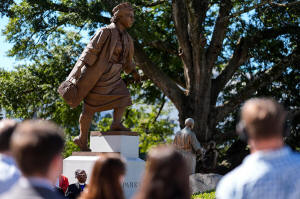Rosa Parks and Helen Keller statues unveiled at the Alabama Capitol
[October 25, 2025]
By KIM CHANDLER
MONTGOMERY, Ala. (AP) — Statues of Rosa Parks and Helen Keller, pivotal
figures who fought for justice and inspired change across the world,
were unveiled Friday on the grounds of the Alabama Capitol.
The monuments honoring the Alabama natives whose advocacy helped
dismantle racial segregation and promoted the rights of people with
disabilities are the first statues of women to be installed on the lawn
of the Alabama Capitol, broadening the history reflected on the grounds
that also include tributes to the Confederacy, which was formed at the
site in 1861.
Gov. Kay Ivey, currently the nation's longest serving female governor,
said Parks and Keller “rose to shape history through quiet strength and
unwavering conviction.”
“Courage changes the course of history, and today, these statutes stand
as symbols of that courage — testaments to what one person, especially
one determined one, can do to make the world a better place,” Ivey said.
Known as the mother of the Civil Rights Movement, Parks was arrested on
Dec. 1, 1955, when she refused to leave her bus seat for a white
passenger. While Parks was not the first woman arrested for defying bus
segregation laws, her arrest became the catalyst for the yearlong
boycott by Black passengers and helped usher in change nationwide.
Born in 1880 in Tuscumbia, Alabama, Keller became deaf and blind after a
serious illness before her second birthday. Her tutor, Anne Sullivan,
taught her to communicate through sign language and Braille, and she
became a well-known writer and lecturer who championed the rights of
workers, poor people, women and people with disabilities.

The statue of Parks, themed as "a step into equality," shows her as if
boarding a bus, just across the Capitol steps from a statue of
Confederate President Jefferson Davis, a fitting location for an icon
who showed "how to fight against racial segregation and inequality in a
non violent way,” the Rev. Agnes M. Lover said.
Parks appears to peer down Dexter Avenue. That's the street where she
boarded the bus that history-making day, and also the site of slave
markets in the 1800s as well as the Rev. Martin Luther King Jr.'s Dexter
Avenue Church, where mass meetings were held to organize the bus
boycott.
Park's statue looks over the grounds where a huge crowd formed at the
end of the 1965 voting rights march from Selma to Montgomery. That her
monument is also just a stone's throw from Davis, who helped tear the
nation apart trying to preserve slavery — is likely to raise some
eyebrows.
[to top of second column]
|

People view a newly unveiled statue of Rosa Parks on the grounds of
the Alabama State Capitol, Friday, Oct. 24, 2025, in Montgomery,
Ala. (AP Photo/Mike Stewart)

The removal of memorials to Confederate figures like Davis was a key
goal of the wave of activism that followed the 2015 slaughtering of
nine Black church parishioners by a white supremacist gunman who
idolized Confederate symbols. More than 480 symbols and statues were
removed nationwide since then, according to the Alabama-based
Southern Poverty Law Center’s “Whose Heritage?” campaign.
But Alabama forbids the removal of longstanding monuments, and while
few cities, such as Birmingham, have defied that law, the Davis
statue remains.
Keller's statue depicts her as a young woman sitting on a bench. In
her lap is a book with instructions, in both text and Braille, on
the technique of tactile lipreading. Visitors are invited to sit
with her figure, placing their face in her outstretched hand.
Keller Johnson Thompson said she knows how pleased her
great-grand-aunt would be, to be honored alongside Parks at the
Capitol. Their stories remind us that no obstacle is insurmountable,
and each of us can make a lasting difference, she said.
“As my aunt Helen so beautifully reminded us, although the world is
full of suffering, it is also full of overcoming it,” Johnson
Thompson said.
Their unveiling on Friday was more than six years in the making.
Alabama lawmakers approved the statues in 2019, and the Alabama
Women’s Tribute Statue Commission completed the project.
Rep. Laura Hall, who sponsored the authorizing legislation, said
visitors to the Capitol should “see the full picture, the history
and the impact that women have played.”
“Helen Keller and Rosa Parks just seemed to be the image that —
whether you were Black or white, Democrat or Republican — you could
identify with and realize the impact that they had on history,” Hall
said.
——
Contributors include Associated Press writer Aaron Morrison in New
York.
All contents © copyright 2025 Associated Press. All rights reserved |